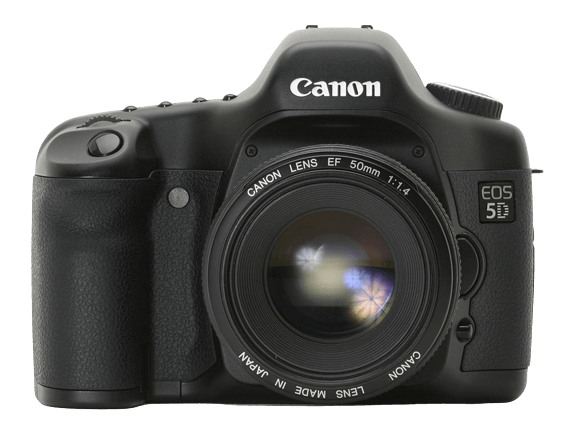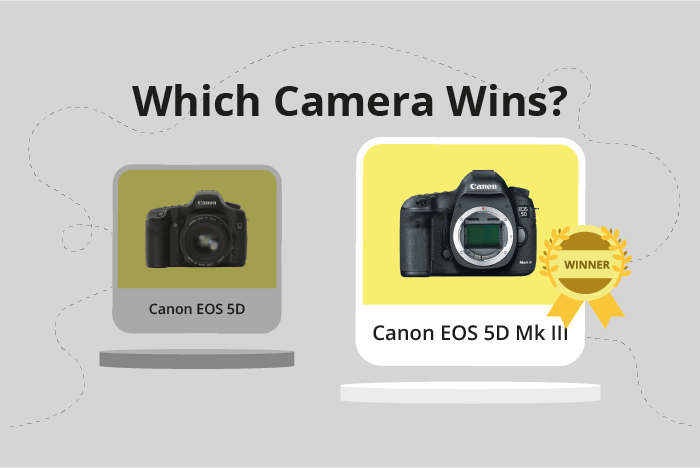Canon EOS 5D vs EOS 5D Mark III Comparison
Canon EOS 5D

Canon EOS 5D Mark III

The Canon EOS 5D Mark III emerges as the winner with a score of 65/100, while the Canon EOS 5D trails behind at 40/100. Both cameras are DSLRs and share similar dimensions, with the Mark III being slightly larger and heavier. The 5D was released in 2005 with a launch price of $2000, while the Mark III came out in 2012 with a heftier price tag of $3499.
The Mark III outperforms the 5D with its higher score, suggesting better overall features and performance. However, the 5D still has its merits, such as its lighter weight and lower price, which may appeal to budget-conscious photographers.
Taking all factors into account, the Canon EOS 5D Mark III is the superior choice for those seeking enhanced performance and features, while the Canon EOS 5D remains a viable option for those prioritizing affordability and weight.
Canon EOS 5D vs EOS 5D Mark III Overview and Optics
The Canon EOS 5D Mark III outperforms the Canon EOS 5D in optics with a score of 67/100 compared to the 5D’s 46/100. Both cameras share common specifications, including a CMOS sensor, full-frame sensor size, Canon EF lens mount, and the absence of image stabilization.
The 5D Mark III’s superiority in optics is evident in its higher megapixel count of 22.3, compared to the 5D’s 12.7, which allows for capturing more detailed images. Additionally, the Mark III offers a faster shooting speed of 6, compared to the 5D’s 3, enabling it to capture fast-moving subjects more effectively. The Mark III also features a more advanced processor, the Digic 5+, which contributes to improved image quality and faster performance. Lastly, the Mark III boasts a higher DXOMARK sensor score of 81, compared to the 5D’s 71, indicating that the Mark III has better overall image quality.
The Canon EOS 5D, though inferior in optics, may have some advantages in specific situations or for certain users. For instance, its lower megapixel count may be sufficient for casual photographers or those who do not require high-resolution images. Furthermore, its lower score and older technology may result in a lower price point, making it a more affordable option for budget-conscious buyers.
When comparing the optics of the Canon EOS 5D and the Canon EOS 5D Mark III, the Mark III is the clear winner with higher scores and better specifications. The 5D, however, may still be a suitable choice for those who prioritize affordability and have less demanding photography needs.
Canon EOS 5D vs EOS 5D Mark III Video Performance
When examining the video capabilities of the Canon EOS 5D and the Canon EOS 5D Mark III, it is important to note that the Canon EOS 5D does not have any video functionality. This means that the camera cannot record videos, and therefore, lacks any related features.
On the other hand, the Canon EOS 5D Mark III has a video score of 56 out of 100. This camera supports Full HD video recording, with a maximum resolution of 1920 x 1080 pixels. Additionally, the Canon EOS 5D Mark III can reach a maximum video frame rate of 60 frames per second, allowing for smooth video capture. However, it is important to note that the camera does not have built-in time-lapse functionality.
Taking these factors into account, it is clear that the Canon EOS 5D Mark III offers video capabilities, while the Canon EOS 5D does not. This distinction is an important consideration for potential buyers, depending on their specific needs and preferences in a camera.
Canon EOS 5D vs EOS 5D Mark III Features and Benefits
The Canon EOS 5D Mark III emerges as the winner in terms of camera features, with a score of 59/100, while the Canon EOS 5D lags behind with a score of 30/100. Both cameras share some specifications, such as the absence of a touchscreen, flip screen, GPS, and Bluetooth.
The 5D Mark III excels in the screen department, boasting a larger 3.2-inch screen compared to the 5D’s 2.5-inch screen. Additionally, the 5D Mark III has a significantly higher screen resolution of 1,040,000 dots, providing a clearer and sharper display than the 5D’s 230,000 dots. However, the 5D Mark III lacks built-in WiFi, which the 5D does have.
On the other hand, the Canon EOS 5D has the advantage of built-in WiFi, allowing for easy sharing and remote control of the camera. Despite this advantage, the 5D falls short in other features compared to the 5D Mark III.
Taking into account the differences in features, the Canon EOS 5D Mark III stands out as a superior camera due to its larger screen size and higher screen resolution, providing a better user experience. The Canon EOS 5D, while offering WiFi connectivity, falls short in other aspects, making the 5D Mark III a more suitable choice for those prioritizing camera features and performance.
Canon EOS 5D vs EOS 5D Mark III Storage and Battery
The Canon EOS 5D Mark III outperforms the Canon EOS 5D in storage and battery with a score of 76/100, compared to the 5D’s 24/100. Both cameras lack USB charging capabilities. However, the 5D Mark III surpasses the 5D in several aspects.
The 5D Mark III has two memory card slots, allowing for more storage options, while the 5D has only one slot. The Mark III accepts SD/SDHC/SDXC cards, Compact Flash, and UDMA cards, whereas the 5D is limited to Compact Flash (Type I or II). The 5D Mark III also boasts a longer battery life of 950 shots, using the LP-E6 battery type, while the 5D offers 400 shots with its BP-511A battery.
The Canon EOS 5D does not have any advantages over the 5D Mark III in terms of storage and battery capabilities. The Mark III’s increased storage options and longer battery life make it the superior camera in this comparison.
Canon EOS 5D vs EOS 5D Mark III – Our Verdict
Are you still undecided about which camera is right for you? Have a look at these popular comparisons that feature the Canon EOS 5D or the Canon EOS 5D Mark III:

